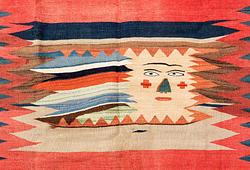Waldemar Lorentzon
"Edelweiss"
Signed Lorentz. Executed in 1928. Canvas 55.5 x 70 cm.
Provenance
Wedding gift 1929 from the artist to Mr John Henrikson, Halmstad.
Thence by descent to present owner.
Exhibitions
The Halmstad exhibition, 1929.
Liljevalchs konsthall, "Halmstadgruppen", 25 February - 19 March 1939, catalogue no. 131, cat. no. 109.
More information
On the 8th of February 1924, Waldemar Lorentzon and his cousin Erik Olson arrived in Paris, where the cosmopolitan dynamism of the French capital made a powerful impression on the two young artists. On the 1st of March, they moved in to two rooms at Rue Notre-Dame-des-Champs 86 owned by the sculptor Arvid Källström’s , a well-known address in artistic circles. Isaac Grünewald’s studio was on the next floor, next to composer Gösta Nystroem. A couple of days after moving in, Lorentzon and Olson were presented to Léger in his studio across the courtyard; a meeting that came to be highly significant for the continued development of the young artists in the 1920s. Léger’s Cubist painting became an important source of inspiration and they both absorbed his theories when they started studying at Léger’s school, the Academie Moderne. Léger passed on his ideas to his students, inspiring them to see the ‘plastic shapes’ in their immediate surroundings: the discs of road signs, the tubes of factory chimneys, etc. They learned to fill the picture surface with large-scale architectural shapes and clearly defined areas of pure, clear colours.
Towards the end of the 1920s, Waldemar Lorentzon completed a number of paintings of athletic figures in motion built up from rhythmical zig-zagging lines. The sporting movement was emerging and becoming extremely important in the early twentieth century, in parallel with urbanisation and Modernism. The Olympic Games in Paris in 1924 fuelled public interest in sport, which was also reflected in art. In this work, “Edelweiss” from 1928, Lorentzon translates Fernand Léger’s lessons into practice. The bodies of the mountaineers have taken on plastic, turbine-like shapes that almost look machine-manufactured. The fields of colour, dominated by unmixed primary colours of blue, yellow and red are bordered by clear contours and contrast with each other. The steep mountains create dramatic diagonals in the picture, standing out sharply against the blood-red background. In strong contrast to the monumental composition, the fragile, little Edelweiss flowers seem barely visible at first glance.
Waldemar Lorentzon’s rare paintings from the second half of the 1920s are a high point in his career as an artist. The work in the auction was given as a wedding present in 1929 and has been in the same family’s ownership ever since. The painting has never previously been sold at auction.







































































